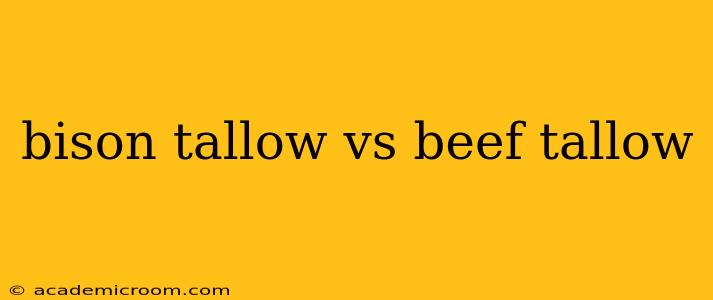Both bison and beef tallow are rendered animal fats offering similar benefits, but subtle differences exist in their composition and applications. This comparison delves into the nuances of each, helping you determine which might be best suited for your needs. Choosing between bison and beef tallow often comes down to personal preference, ethical considerations, and specific uses.
What is Tallow?
Before diving into the comparison, let's establish a common understanding. Tallow is the rendered fat from the suet (the hard fat) of cattle (beef tallow) or bison (bison tallow). It's a rich source of saturated fats, particularly stearic acid, and has been used for centuries in cooking, skincare, and even candle-making.
Bison Tallow vs. Beef Tallow: Key Differences
While both share many similarities, several key factors differentiate bison and beef tallow:
Fatty Acid Composition:
Both bison and beef tallow boast high levels of saturated fats, but their exact profiles differ slightly. Bison tallow generally has a higher concentration of stearic acid, a saturated fat that's considered more stable at room temperature and less likely to oxidize (go rancid) compared to other saturated fats. This can translate to a longer shelf life for bison tallow. However, the exact composition can vary based on factors such as the animal's diet and age. Precise compositional analysis would require laboratory testing.
Source and Sustainability:
This is a crucial difference for many consumers. Bison are generally raised in more sustainable and environmentally friendly ways than conventionally raised beef cattle. Bison require less land and water, and their grazing habits can help improve grassland health. However, it's important to research the specific sourcing of your tallow—look for producers who prioritize ethical and sustainable practices, regardless of the animal source.
Flavor and Aroma:
While subtle, a difference exists in flavor and aroma. Bison tallow often possesses a slightly milder, less intense flavor than beef tallow. This is a significant consideration for cooking, especially when the tallow's flavor is intended to be a prominent element in the dish. Some find beef tallow imparts a richer, more savory note, while others prefer the milder taste of bison tallow.
Cost:
Generally, bison tallow is more expensive than beef tallow. This is due to a combination of factors, including lower bison production compared to beef cattle, and potentially higher demand from those seeking a more sustainable or unique product.
Availability:
Bison tallow is less readily available commercially compared to beef tallow. You may need to shop more specifically or order online to find sources of bison tallow.
Frequently Asked Questions (PAA)
While direct PAA results can fluctuate, these are common questions surrounding bison and beef tallow:
Is bison tallow healthier than beef tallow?
Both bison and beef tallow are primarily composed of saturated fats. Current scientific consensus doesn't definitively declare one healthier than the other; the health impacts depend on individual dietary needs and overall eating habits. Both can be part of a healthy diet in moderation.
Which tallow is better for cooking?
The "better" tallow for cooking is subjective. Bison tallow's milder flavor might be preferred for dishes where you want the tallow's flavor to be subtle, while beef tallow's richer taste suits situations where a more pronounced savory note is desired.
Which tallow is better for soap making?
Both bison and beef tallow are suitable for soap making, although their slightly differing fatty acid compositions will influence the final soap's properties. Experimentation might be necessary to determine personal preference.
Where can I buy bison tallow?
Bison tallow can often be purchased from online retailers specializing in natural products, or from producers who sell directly. Local farmers markets may also be a source, but availability can vary considerably.
What are the benefits of using bison tallow?
Bison tallow shares the general benefits of tallow: high smoke point, suitability for cooking and skincare, and potential benefits related to its saturated fat content. The potential for more sustainable sourcing is also a benefit for many consumers.
Conclusion
The choice between bison and beef tallow is a matter of personal preference and priorities. Both offer unique characteristics, from flavor profiles to sourcing ethics. Consider your cooking style, ethical concerns, budget, and desired characteristics to make the best decision for your needs. Remember to always source your tallow from reputable suppliers who prioritize quality and sustainable practices.
